A healthy email list is an essential part of growing a successful blog. I have yet to come across any blogger who doesn’t recommend setting up a newsletter at the very beginning.
It is super easy to set-up an account with an email provider, and to start sending out newsletters with apps like Mailchimp, Convertkit, MailerLite, and many others.
Besides setting up your list, there are some essential things that you need to do to, which, when overlooked, can result in your newsletter going to spam, and poor engagement.
Is this you?
- My email open rate is low
- I suspect my emails are going to the spam folder
- My link click rate is low
- No one is engaging in my newsletters
- My unsubscribe rate is high
When no one opens your emails and engages with your content, all your hard work building your list will have gone to waste. Plus, it’s pretty demoralizing, isn’t it?
In today’s post, I will reveal exactly what I did to take my newsletter open rate up to 50.5%. I will take you through how you can give your emails the best chance possible of making the inbox and gaining higher engagement.
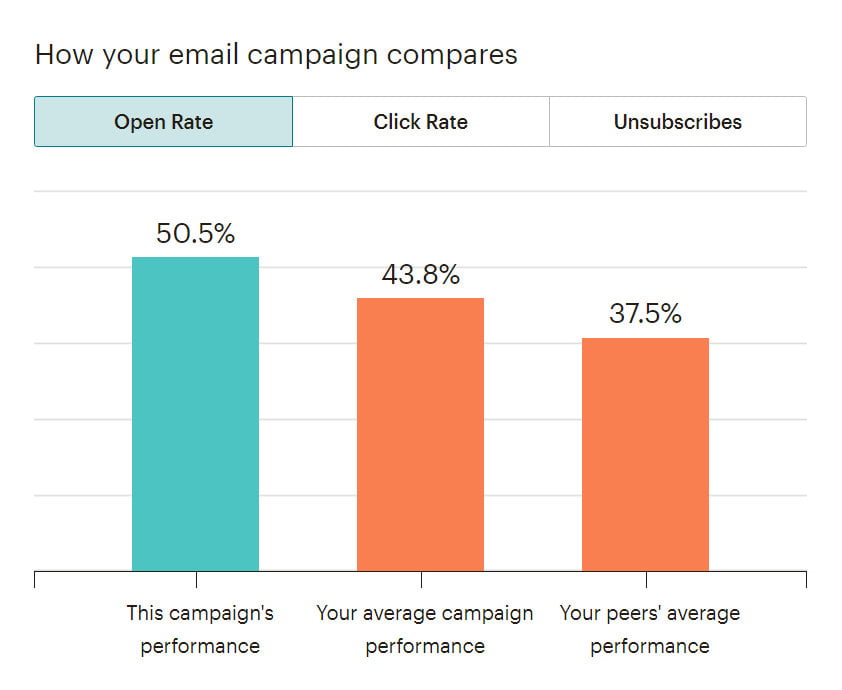
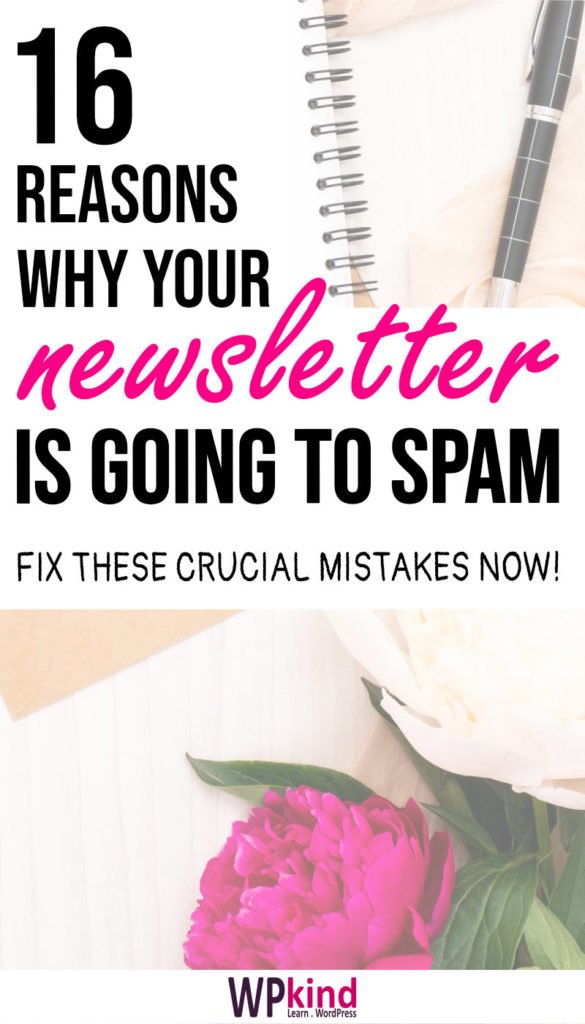
1. Keep your emails on-topic
I’m going to start with the obvious. Only write emails about the topic that your subscribers signed up to receive.
Your subscribers signed up because they wanted to hear about the subject that you promised them at the start. If your email is on a different topic, you can’t expect to retain the same level of engagement, plus you risk people clicking the unsubscribe link.
If you plan to change the focus of your newsletter, then it only seems right to let your subscribers know and give them the chance to resubscribe to your new type of list.
Alternatively, start a new list and ask those who are interested to subscribe to it separately.
I know of a few bloggers who have a list about blogging, separate from their main blog topic. Two blogs in particular that I follow, MommyOnPurpose and JenniferMaker, have great tips to share on blogging which they deliver through a different list.
2. Don’t put too many images in your email
Newsletters, where images overpower content, are more likely to end up in the spam box.
Newsletters are not blog posts. The simpler your email, the more likely it will appear as a personal letter and therefore avoids the spam filter.
Many people turn off images on emails, so you shouldn’t rely on them to convey your message.
If you do include images, make sure they always have an ALT description, just as you would do for blog posts.
3. Don’t use a spammy subject line
Think about your subject line carefully, and avoid making it look like clickbait. An example of a spammy title would be one that includes lots of exclamation marks, using all capital letters, or starting with ‘Re:’ (a classic spammy subject line).
I found some handy tips in this blog post for keeping a subject line non-spammy.
4. Use a preheader or preview line
Most email programs let you add a preheader, also known as a preview line or subheading to your email. A preheader appears directly after the subject line in the inbox. You can usually enter it along with the subject line when you compose your email.
Using a preheader doesn’t necessarily keep your email out of spam, but it can make an email more inviting to click if you choose your words carefully.
5. Keep your list clean
Regularly clear out subscribers who never open your emails. The more people that open your emails, the better. Having lots of disengaged contacts on your list can be damaging for your reputation. A high reputation is essential for avoiding the spam box!
So how do you clean a list?
The method for cleaning a list depends on which email app you are using.
On Mailchimp, you could create a segment based on contacts that did not open any of the five previous campaigns, and who subscribed more than a month ago. You could then archive all the contacts in that segment or send them an email to ask them to click a link if they are still interested.
Once a cold contact has opened an email and clicked a link they won’t appear in your segment any longer.
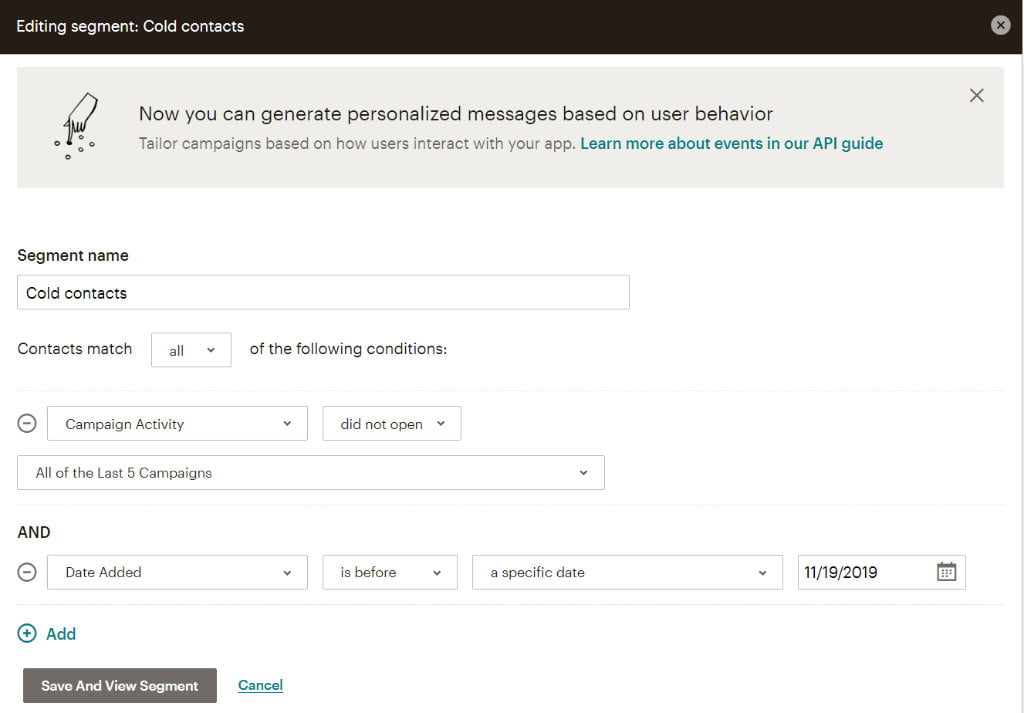
ConvertKit has a built-in segment called Cold Subscribers. These are subscribers who haven’t opened or clicked a link in the last 90 days and who subscribed more than 30 days ago.
ConvertKit has a handy tutorial on their blog about how to gracefully prune a list of these cold subscribers, without removing false positives.
How to Prune Cold Subscribers from your List
6. Use a reputable email provider
Don’t be tempted to use your computer’s email app to send out newsletters. It might seem the easiest and cheapest option, but it is a sure way to get your email in the spam box! There are several reasons why it is a bad idea, including the lack of an unsubscribe mechanism, plus privacy concerns when everyone’s email is on show.
If you are looking for a free option, Mailchimp has a free tier for up to 2,000 contacts, and MailerLite’s free tier includes 1,000 contacts. There is no excuse not to use a dedicated newsletter app!
All the big email providers make it their duty to do all they can to get your email into the recipient’s inbox.
Here are my top picks for the best email providers:
- MailChimp (free tier up to 2,000 contacts)
- MailerLite (free tier up to 1,000 contacts)
- ConvertKit
- Constant Contact
- Active Campaign
7. Use your own domain to send emails and get it verified
A lot of people don’t bother to use their own domain to send an email and use a free Gmail, Yahoo, or Hotmail account instead.
It is easy to pick out the emails where people are using a non-verified domain because the ‘from’ address will be something like this:
[email protected] via mailchimpapp.net
This type of ‘from’ address is more likely to end up in spam box, plus it doesn’t look as professional and trustworthy as using your own domain.
At Mailchimp, it isn’t possible to verify a non-domain email address such as Gmail or Hotmail. At ConvertKit, they discourage you from using a free email account.
The best option is to create an email address for your domain, but don’t worry, it isn’t difficult to do.
There are a couple of ways you can get a domain email, through your hosting provider or via another dedicated service such as Google GSuite.
Most hosting providers provide free domain email along with a hosting plan. You can set up an email address in your web hosting control panel. If you have trouble, do contact your host for support.
Google GSuite isn’t free, but along with email, you get Google Docs, Calendar and Tasks. I have used GSuite for several years and found it reliable and easy to set up. Having email hosted separately means it never goes down should there be a problem with your web hosting. Plus, it makes it easier to change web hosts quickly without affecting your email.
When you get your domain email, the next step is to verify it with your email service. It is straightforward to do and typically involves clicking a link in an email.
Verify an email address on MailChimp
ConvertKit combines the domain verification process with authentication, which is what I talk about next.
8. Authenticate your domain
In addition to verifying your domain, there is more you can do to improve deliverability by authenticating it.
Authentication is essential if you want to get the highest possible deliverability for your newsletter.
Each newsletter app will have a different method for authentication, but it will involve adding DKIM and SPF entries into the DNS records of your domain. Your email provider should tell you exactly what to do and what domain records to add.
Here are the relevant articles from Convertkit and Mailchimp:
I don’t recommend editing the DNS records of a domain unless you know what you are doing. Mistakes can cause your website or email to break.
If your hosting provider has control of the DNS records, then it is a good idea to ask them to add the relevant records for you if you at all unsure.
9. Check deliverability with Mail-Tester
Once you have verified and authenticated your sending domain, I recommend checking your newsletter with a deliverability checker.
There is a fantastic free online tool called Mail Tester, which provides an overall score based on how likely they think your newsletter will reach your recipient’s inbox.
The tool checks your newsletter through a filter called SpamAssassin; it also checks the DNS on your domain for the correct DKIM and SPF records that we talked about earlier.
I always make it a habit to check every newsletter with Mail Tester before I hit send. I usually get a 9/10 but occasionally a 10/10 which I love to see!
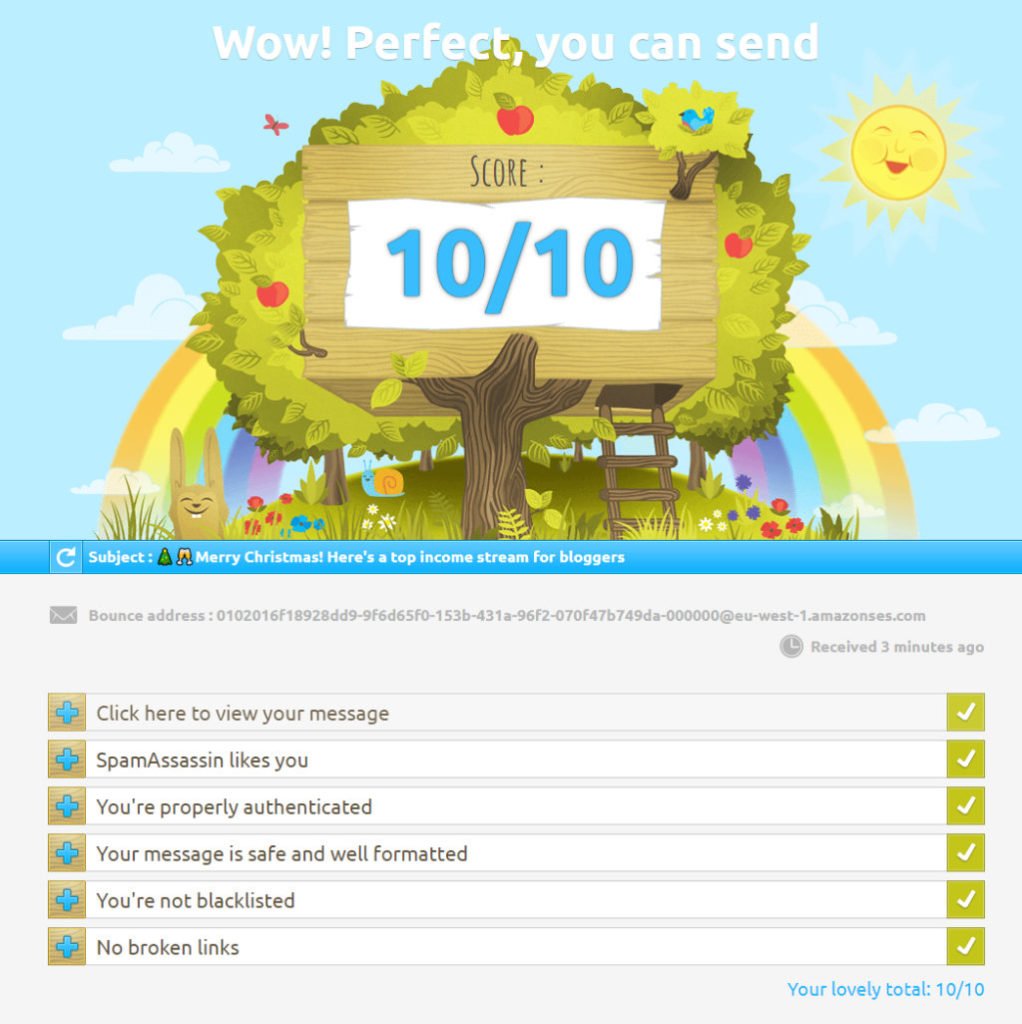
1. Keep your emails on-topic
No matter what you do, emails can sometimes arrive in the spam folder for apparently no reason what-so-ever.
After all I had done to test my new email course, the last check was to sign up myself, and guess what?
Gmail spammed the last email, UGH!
Unfortunately, it took me a week to notice because that was when the last email in the course went out.
Even though I had a very high score from MailTester that message still ended up in SPAM.
What to do? I immediately Googled it, of course. I soon found another mail testing tool called Spam Analyse. It’s very basic looking, but this tool is just amazing.
Spam Analyse checks the text of the email for spammy words, making it a perfect partner to MailTester, which focuses on the authentication and the format of the email.
Paste in the text of your email or the HTML, and it will bring back a score plus comments on how to improve.
This is what I got back from my spammed email:
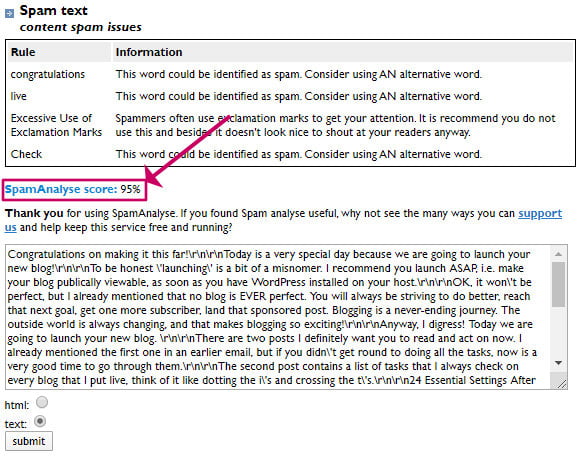
Now you would think that 95% isn’t too bad, but it must have been enough to get the email spammed.
Who knew that too many exclamation marks could cause a problem!!
I can understand that the word ‘congratulations’ could be spammy, but ‘live’ and ‘check’, really?
Does anyone know another word for ‘click’?
Rather annoyingly, I found that the word ‘click’ is also a spammy word, which is a nuisance since I often send out techie newsletters where I need to write that word.
I made the changes and rechecked, and then guess what, Gmail stopped spamming it, result!
10. Only send emails to people who have given their consent
Never add email addresses to your list unless they have expressly opted in through your sign up form.
It is not a good idea, for example, to add emails you picked up from a conference or sales event unless you obtained specific permission to email at the time.
11. Use a double opt-in AND a Recaptcha
Many people advise that you should always use a double-opt-in sign-up process.
A double-opt-in is where a potential subscriber has to confirm their email address before becoming part of your list.
A double-opt-in helps to ensure that only legitimate users arrive on your list. However, unless you have a ReCaptcha, spammers can still get through, even though confirmation is necessary. The little blighters have found a way to confirm automatically!
Personally, I am undecided whether a double-opt-in is worth it, and I am currently trialling a single-opt-in method.
I am not convinced that double-opt-in it is actually a requirement for GDPR compliance. The critical thing in my view is to always get people’s permission as part of the sign-up process and to give them every opportunity to unsubscribe. You can do this by requiring people to tick a box in the sign-up form to agree to be emailed, and by adding a prominent unsubscribe link to every email.
When using double-opt-in, I noticed that about 25% of opt-ins remained unconfirmed. Did people forget to check their email for the confirmation? Or did the confirmation end up in the spam folder due to it being so short? It’s difficult to diagnose the cause, and that is why I decided to try single-opt-in for a while.
Before considering a single-opt-in approach, you should make sure that your opt-in has a Recaptcha. Recaptchas stop machines from automatically signing up.
As I said earlier, even a double-opt-in needs a ReCaptcha. I found that though an email required to be confirmed, bots had a way to do it automatically. The double-opt-in had no effect on spam sign-ups!
Before going for single-opt-in, I made sure that the first welcome email I send includes a very clear message at the top, reminding people to unsubscribe if they didn’t mean to do it or have second thoughts.
Since turning off the email confirmation, my list has increased at a faster rate, but it remains to be seen how engaged these new subscribers will be.
12. Always include a physical mailing address
If you live in the US, then to comply with the CAN-SPAM act you must add a mailing address to every email.
A good email list provider will always ask you for a physical mailing address. If you don’t want to add you actual home or business address, use a P.O. box address instead.
I have a free plan at UKPostBox, which gives me a free P.O box. Any mail sent to this P.O box will be forwarded to me on a pay as you go basis. I feel more confident giving this address out rather than my home address.
Note that ConvertKit allows you to use their address for free, so there is no need for your own P.O. box.
13. Always include an unsubscribe link
If you use a reputable email company, then the unsubscribe link should get added in automatically for you.
Don’t be tempted to remove the unsubscribe link. Not only should it definitely be there, but it should also be easy to find. People who can’t find an unsubscribe link are more likely to report your email as spam instead.
I like to put an additional unsubscribe line at the beginning of my welcome email, to make it especially obvious for new subscribers.
As a side note, you must not be discouraged if people unsubscribe from your list. They are not your tribe, they probably haven’t been opening your emails, and they are unlikely ever to become a raving fan, so it is best for everybody that you part company.
14. Brand your emails
Always use the same from address and name in all your emails so that people recognise you instantly.
I also like to stick to a standard template design. Clean and simple is my preference.
Remember that you shouldn’t overload your template with too many images as it can be a red flag for spam. Adding your logo should be fine, though.
15. Add a Recaptcha to your sign-up form
I already mentioned that Recaptchas are a very good idea for preventing spam sign-ups, but I’ll repeat myself here for effect!
Sign-up forms are a magnet for spammers. You don’t want your subscriber list clogged up with lots of spammy email addresses.
You can prevent, and pretty much eliminate this by adding a Recaptcha to sign-up forms.
In most cases, Recaptchas are added automatically via the email provider. If you use a third-party plugin to make the sign-up form like Elementor or Thrive Architect, make sure you use the Recaptcha option they provide.
Elementor has a ‘honeypot’ option for all forms, which is a simple and effective alternative to a Recaptcha. A honeypot is a hidden input field which cannot be seen or completed by a real person. Only bots will fill out a honeypot field when completed, we know to throw them out immediately.
16. Ask users to add your email address to their address book
Always ask new subscribers to add your email address to their contacts list. I always add a line to my welcome email to this effect:
Don’t forget to add this address to your contacts, that way emails from me shouldn’t end up in on your spam folder.
In this post, I’ve taken you through everything I do to ensure that the newsletters I send out have the best possible chance of making it to the inbox. Let me know how it improves your open rate in the comments section below.



